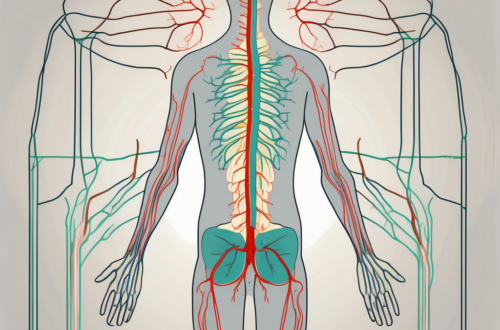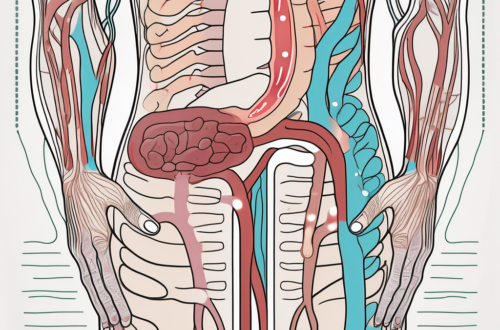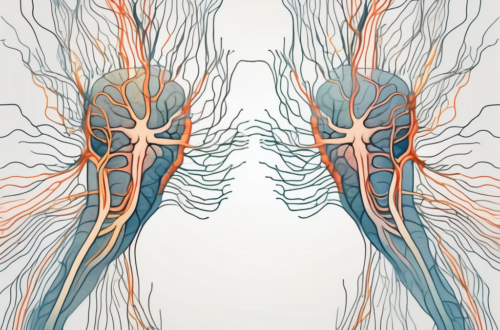Swallowing is a complex physiological process that we often take for granted. It involves multiple muscles and nerves working in harmony to ensure the smooth passage of food and liquids from our mouths to our stomachs. One crucial player in this intricate dance is the parasympathetic nerve, a branch of the autonomic nervous system responsible for regulating many vital functions of our bodies, including digestion.
Understanding the Parasympathetic Nervous System
The parasympathetic nervous system is one of the two main divisions of the autonomic nervous system, the other being the sympathetic nervous system. While the sympathetic nervous system is responsible for our “fight or flight” response, the parasympathetic nervous system acts as its counterpart, promoting relaxation and regulating restorative processes.
The anatomy of the parasympathetic nervous system is intricate and fascinating. It consists of a network of nerves primarily originating from the cranial and sacral regions of the spinal cord. These nerves extend to the various organs and tissues of the body, including the muscles involved in swallowing.
Let’s delve deeper into the anatomy of the parasympathetic nervous system. The cranial region of the spinal cord gives rise to several cranial nerves, including the vagus nerve (tenth cranial nerve), which plays a vital role in controlling the parasympathetic functions. The vagus nerve branches off from the brainstem and travels down through the neck and chest before distributing fibers to the heart, lungs, and digestive tract. Its extensive reach allows it to exert its influence on multiple organs simultaneously.
The Anatomy of the Parasympathetic Nervous System
The vagus nerve, being the primary controller of the parasympathetic nervous system, is a remarkable structure. It is the longest cranial nerve, extending from the brainstem all the way down to the abdomen. Along its course, it forms intricate connections with various organs, enabling precise regulation of their functions.
One of the fascinating aspects of the vagus nerve is its role in coordinating the complex muscle movements involved in swallowing. As food passes through the esophagus, the vagus nerve orchestrates the sequential contraction and relaxation of the muscles, ensuring the smooth passage of the bolus into the stomach. Without the precise control provided by the parasympathetic nervous system, swallowing would be a challenging and inefficient process.
Functions of the Parasympathetic Nervous System
The parasympathetic nervous system is responsible for various functions essential to our bodies’ overall function and well-being. It regulates heart rate, controls respiratory function, stimulates the production of saliva, and promotes digestion. It is the latter function that is particularly relevant to the role of the parasympathetic nerve in swallowing.
When we eat, the parasympathetic nervous system is activated, leading to increased blood flow to the digestive organs and the secretion of saliva and digestive enzymes. These physiological responses help prepare the digestive system for the intake and processing of food.
Furthermore, the parasympathetic nervous system plays a crucial role in maintaining homeostasis in the body. It helps regulate blood pressure, body temperature, and other vital functions necessary for our well-being. Without the parasympathetic nervous system’s meticulous control, our bodies would struggle to maintain a stable internal environment.
In summary, the parasympathetic nervous system is a remarkable and intricate network of nerves that controls various essential functions in our bodies. From regulating digestion and coordinating swallowing to maintaining overall homeostasis, this system plays a crucial role in keeping us healthy and functioning optimally.
The Swallowing Process: An Overview
As mentioned earlier, swallowing is a complex process that involves multiple phases and various muscles working in synchrony. This section provides an overview of the swallowing process.
Swallowing is a fundamental physiological process that allows us to consume food and liquids, providing our bodies with the necessary nutrients and hydration. It is a seemingly effortless action that we perform multiple times a day, but behind this seemingly simple act lies a complex series of events that ensure the smooth progression of the bolus through the digestive tract.
The Phases of Swallowing
Swallowing can be divided into three distinct phases: the oral phase, the pharyngeal phase, and the esophageal phase.
- The oral phase is initiated voluntarily as we prepare to swallow by forming a cohesive bolus with our tongues and moving it to the back of our mouths. This phase is crucial as it sets the stage for the subsequent phases of swallowing. The tongue, with its intricate network of muscles, plays a pivotal role in manipulating the food or liquid into a compact bolus, ready for the next phase.
- The pharyngeal phase is when the involuntary part of swallowing begins. At this stage, the bolus moves into the pharynx, triggering a cascade of reflexes that close off the airway and direct the bolus towards the esophagus. The muscles in the pharynx contract in a coordinated manner, squeezing the bolus towards the esophagus while preventing any entry into the trachea, ensuring that food and liquid go down the right path.
- The esophageal phase involves the involuntary contraction of the esophagus muscles, which propel the bolus downward towards the stomach. This phase is crucial for the transportation of the bolus through the esophagus, a muscular tube that connects the throat to the stomach. The rhythmic contractions of the esophageal muscles, known as peristalsis, create a wave-like motion that propels the bolus forward, ensuring its efficient delivery to the stomach.
Each phase of swallowing is precisely orchestrated, with the involvement of various muscles and nerves, including the parasympathetic nerve, ensuring the smooth progression of the bolus through the digestive tract. The parasympathetic nerve, part of the autonomic nervous system, plays a crucial role in coordinating the involuntary muscle movements involved in swallowing, ensuring that the process occurs seamlessly.
The Muscles Involved in Swallowing
Swallowing requires the coordinated action of over 50 muscles. These muscles can be divided into two main groups: the voluntary muscles in the mouth and throat, and the involuntary muscles in the esophagus and other parts of the digestive system.
During the oral phase, voluntary muscles, such as the tongue and throat muscles, move the bolus to the back of the mouth. The tongue, with its complex arrangement of muscles, plays a central role in manipulating the bolus, ensuring that it is properly formed and positioned for swallowing. The throat muscles, including the pharyngeal constrictor muscles, work in harmony with the tongue to propel the bolus towards the pharynx.
Once the pharyngeal phase begins, involuntary muscles take over, initiating a series of contractions that propel the bolus towards the stomach. These involuntary muscles include the pharyngeal constrictor muscles, which contract in a coordinated manner to squeeze the bolus towards the esophagus, and the esophageal muscles, which contract rhythmically to propel the bolus through the esophagus towards the stomach.
The parasympathetic nerve plays a vital role in coordinating these involuntary muscle movements, ensuring the efficient swallowing of food and liquids. It sends signals to the muscles involved in swallowing, triggering the appropriate contractions and relaxation needed for the smooth progression of the bolus through the digestive tract.
The Parasympathetic Nervous System and Swallowing
The connection between the parasympathetic nervous system and swallowing is significant. The primary conduit through which the parasympathetic nerve influences the swallowing process is the vagus nerve.
The vagus nerve, also known as the tenth cranial nerve, is the longest and most complex of the cranial nerves. It originates in the brainstem and extends down to the abdomen, innervating various organs along the way. As mentioned earlier, the vagus nerve is responsible for carrying parasympathetic signals to the various organs involved in digestion, including the muscles required for swallowing.
The Role of the Vagus Nerve in Swallowing
The vagus nerve acts as a critical mediator, ensuring the coordination and timing of muscle contractions during the swallowing process. Without its influence, the smooth progression of food and liquids from the mouth to the stomach would be compromised.
When the vagus nerve is activated, the muscles in the mouth and throat contract, propelling the food or liquid bolus through the pharynx and into the esophagus. Simultaneously, the muscles of the esophagus contract to transport the bolus towards the stomach.
But how does the vagus nerve know when to initiate these muscle contractions? The answer lies in the sensory feedback it receives from various structures involved in swallowing. Specialized receptors in the oral cavity, pharynx, and esophagus detect the presence of food or liquids and send signals to the brainstem via the vagus nerve. These signals trigger the appropriate motor responses, ensuring the timely and coordinated movement of the bolus.
The Impact of Parasympathetic Activation on Swallowing
Activation of the parasympathetic nervous system enhances the overall efficiency and effectiveness of the swallowing process. It promotes the secretion of saliva, which not only helps moisten the bolus but also contains enzymes that initiate the breakdown of starches.
Furthermore, parasympathetic activation stimulates the release of gastric acid and other digestive enzymes, which aid in the breakdown of the bolus as it travels through the digestive tract. This activation also facilitates peristalsis, the coordinated muscular contractions that push the bolus towards the stomach.
It is worth noting that the parasympathetic nervous system’s influence on swallowing is just one piece of the puzzle. Multiple other factors, such as the integrity of the neural pathways involved and the overall health of the muscles and structures involved, also contribute to the smooth functioning of swallowing.
For example, the cranial nerves other than the vagus nerve also play crucial roles in swallowing. The glossopharyngeal nerve, another cranial nerve, is responsible for initiating the swallowing reflex by triggering the closure of the airway and the elevation of the larynx. The hypoglossal nerve, yet another cranial nerve, controls the movements of the tongue, which is essential for manipulating the bolus during chewing and swallowing.
Additionally, the muscles involved in swallowing need to be in optimal condition for efficient swallowing. Any weakness or dysfunction in these muscles can lead to difficulties in swallowing, known as dysphagia. Conditions such as stroke, Parkinson’s disease, and muscular dystrophy can affect the muscles involved in swallowing, resulting in swallowing difficulties.
In conclusion, the parasympathetic nervous system, particularly through the vagus nerve, plays a crucial role in the coordination and regulation of swallowing. Its activation enhances the efficiency of the swallowing process by promoting saliva secretion, initiating the release of digestive enzymes, and facilitating peristalsis. However, it is important to recognize that swallowing is a complex process involving multiple neural pathways and muscle groups, and any disruption in these components can lead to swallowing difficulties.
Disorders Related to Swallowing and the Parasympathetic Nervous System
While the parasympathetic nervous system plays a crucial role in ensuring proper swallowing, its dysfunction can lead to various swallowing disorders, the most common of which is dysphagia.
Swallowing is a complex process that involves the coordination of multiple muscles and nerves. It begins with the voluntary movement of food or liquid into the mouth, followed by the involuntary contraction of muscles in the throat and esophagus to propel the swallowed material into the stomach. The parasympathetic nervous system, a division of the autonomic nervous system, is responsible for regulating these involuntary muscle contractions and ensuring the smooth passage of food and liquid through the digestive tract.
Dysphagia: A Swallowing Disorder
Dysphagia is a term used to describe difficulties or discomfort when swallowing. It can occur at any stage of the swallowing process and has various underlying causes, including neurological conditions, muscle weakness or damage, and structural abnormalities.
When the parasympathetic nerve’s function is compromised, such as in cases where the vagus nerve is damaged or disrupted, dysphagia can result. The coordination of muscle contractions may be impaired, leading to inefficient or incomplete swallowing.
Individuals with dysphagia may experience symptoms such as choking, coughing, or a sensation of food getting stuck in the throat. This can have a significant impact on their quality of life, as it may lead to malnutrition, dehydration, and respiratory complications.
It is crucial for individuals experiencing difficulty swallowing or any related symptoms to seek medical attention promptly. A healthcare professional, such as a speech-language pathologist or otolaryngologist, can assess the underlying cause of dysphagia and recommend appropriate treatment strategies.
The Effect of Parasympathetic Dysfunction on Swallowing
Parasympathetic dysfunction can have a profound impact on swallowing. In addition to dysphagia, it can lead to inadequate saliva production, impairing the initial stages of the swallowing process. Reduced gastric acid secretion and decreased muscle contractions in the digestive tract can also contribute to difficulties in efficient swallowing and digestion.
Furthermore, parasympathetic dysfunction can affect other bodily functions, such as heart rate, blood pressure, and pupil constriction. This highlights the interconnectedness of the parasympathetic nervous system with various physiological processes.
Addressing parasympathetic dysfunction requires a multi-faceted approach that may include medical interventions, lifestyle modifications, and targeted therapies to enhance parasympathetic function. Medications that stimulate parasympathetic activity, such as cholinergic drugs, may be prescribed to improve swallowing function. Additionally, dietary changes, such as modifying food texture or consistency, can help individuals with dysphagia manage their symptoms.
It is essential for individuals experiencing symptoms of parasympathetic dysfunction to consult with a healthcare professional who can guide them through appropriate management strategies. With proper diagnosis and treatment, individuals with swallowing disorders can regain their ability to eat and drink safely, improving their overall well-being and quality of life.
Treatment and Management of Swallowing Disorders
The treatment and management of swallowing disorders, including dysphagia, depend on the underlying cause and severity of the condition. Healthcare professionals specializing in swallowing disorders employ a wide range of therapeutic approaches to address these challenges.
Therapeutic Approaches for Dysphagia
Speech-language pathologists, also known as swallowing specialists, play a crucial role in the assessment and treatment of dysphagia. They employ a variety of techniques and exercises to improve swallowing function.
These may include strengthening exercises for the muscles involved in swallowing, modifying food and liquid textures to facilitate safe swallowing, and implementing compensatory strategies to minimize the risk of aspiration. In some cases, medications or surgical interventions may also be recommended to address underlying structural or neurological issues.
Enhancing Parasympathetic Function for Swallowing Improvement
Enhancing parasympathetic function may be a part of the broader treatment approach for certain swallowing disorders. However, it is important to note that the specific strategies for enhancing parasympathetic function are still under investigation, and more research is needed in this area.
Current studies exploring potential methods for enhancing parasympathetic function range from pharmacological interventions to complementary therapies. It is always advisable to consult with a healthcare professional before attempting any intervention targeting the parasympathetic nervous system.
Future Research Directions in Parasympathetic Nervous System and Swallowing
The role of the parasympathetic nervous system in swallowing is an active area of research, with scientists and clinicians continually seeking to deepen our understanding of this intricate connection.
Potential Areas of Study
Future research may explore the specific neural pathways and mechanisms by which the parasympathetic nervous system regulates swallowing. This includes investigating how parasympathetic dysfunction affects the various stages of swallowing and exploring new strategies for enhancing parasympathetic function.
The Importance of Continued Research
Research focusing on the parasympathetic nervous system’s role in swallowing is crucial for advancing both our theoretical understanding and clinical management of swallowing disorders. By shedding more light on the complex interactions between the parasympathetic nerve and the swallowing process, researchers aim to develop targeted therapies and interventions that can effectively address swallowing challenges and improve individuals’ quality of life.
In conclusion, the parasympathetic nerve plays a crucial role in the intricate process of swallowing. As part of the autonomic nervous system, the parasympathetic nervous system promotes relaxation and regulates many crucial functions, including digestion. Through its control of the vagus nerve, the parasympathetic nervous system coordinates the muscle movements required for efficient swallowing.
Disorders related to swallowing and the parasympathetic nervous system, such as dysphagia, can significantly impact an individual’s ability to safely and comfortably swallow. However, with the help of healthcare professionals specializing in swallowing disorders, tailored treatments and management strategies can be implemented to address these challenges.
As our understanding of the parasympathetic nervous system’s role in swallowing continues to evolve, further research in this field holds great promise for the advancement of diagnostic techniques and therapeutic interventions. By enhancing our knowledge of the complex mechanisms involved, we can develop more targeted and effective approaches to support individuals with swallowing disorders, working towards a healthier and more comfortable experience of swallowing for everyone.





